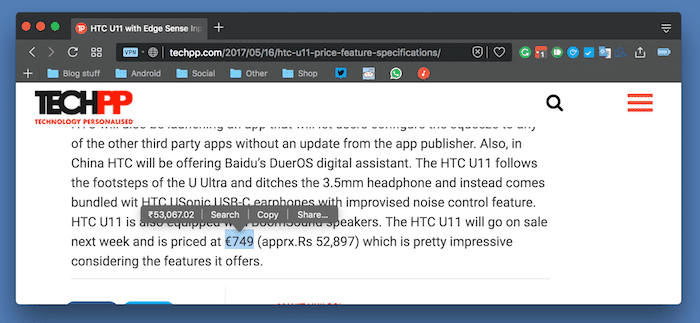1. Google Chrome Extensions
One of the few reasons why most users hesitate to leave Chrome is due to its extensive support for third-party apps and extensions. Thankfully, though, Opera is based on the same architecture Google Chrome runs on. Hence you can install extensions from Chrome’s web store directly on Opera. The process is quite straightforward as well, head over to this link and download the Opera add-on. Once that is done, open the page of the Chrome extension you’d like to install and click the “Add to Opera” button. You’ll then be redirected to the extensions page where you need to tap the Install button, accept the warnings and you’re good to go.
2. Opera Turbo
Opera also packs a nifty little utility if you’re on a slow network called ‘Opera Turbo’. It essentially compresses many graphics like images and ads while you are browsing and turns off any other pre-loading feature that consumes more data. The setting for Opera Turbo is available in the main drop-down menu.
3. VPN
One of the biggest perks of using Opera is the availability of an inbuilt VPN that lets you browse through many different countries. VPN is disabled by default, for enabling it, open the settings or preferences, search for ‘VPN’ and check the ‘enable VPN’ option. Now, whenever you’d like to switch it on, just tap the little ‘VPN’ button located on the search bar. And yeah, you can change the location if you wish, and you have 5-6 countries to choose from.
4. Tab Manager
Additionally, Opera comes with a native tab manager which you can use while hopping between multiple tabs and windows. It is accessible by tapping the downward arrow icon located on the top right corner. The panel even shows the list of your recently closed tabs if you’d like to visit them again without the hassle of loading up the history page.
5. The Sidebar
The sidebar is one of the most overlooked aspects of Opera. However, it plays a key role here. Apart from permanently pinning the sidebar for quick access to your history, bookmarks, you can also install sidebar apps and also, include web apps for WhatsApp, Telegram or Facebook Messenger. While the latter comes installed out-of-the-box, you can download more add-ons that support the sidebar functionality such as Google Keep, Instagram, and other similar titles. For installing a new sidebar app, fire up the Opera extensions store and tap the sidebar link. This will list down all the apps which are compatible with it; you can click the desired app and install. That’s about it; the app will be available in the sidebar panel.
6. Battery Saver
Running low on power? Switch on Opera’s battery saver that turns off any battery-hogging features and extensions. The battery saver icon is present on the top right corner, clicking on which will also reveal the remaining time of your device.
7. Tab Previews
Another Opera feature that eliminates the need for a third-party extension is “tab previews”. These are also disabled by default mainly because they consume a few extra MBs of your computer’s RAM. To switch it on, head into the settings and search for tab previews. The rest of the process is I think pretty self-explanatory.
8. Dark Theme
Opera recently with its “Reborn” update added a dark theme as well. The mode overhauls the browser’s core components such as toolbars and sidebars with a darker accent primarily. It can be turned on through the preferences.
9. Currency Convertor
Next up on our list is Opera’s indigenous currency converter that automatically translates a foreign currency whenever you select the particular text. Initially, the browser is configured with USD. However, you can alter that in the preferences and set it to just about any other country.
10. Picture in Picture
Lastly, we have the picture-in-picture mode on Opera that allows you pop out a playing video online in a hovering window and you can then watch it while doing something else in another tab. This is usually enabled, however just in case it isn’t, you can search for “Video pop out” in the preferences. Next time you’re watching a video, look for a green icon on the top of that clip. That was all. Those were some of the tips you should be aware of while using Opera. Let us know in the comments section if we missed anything.







